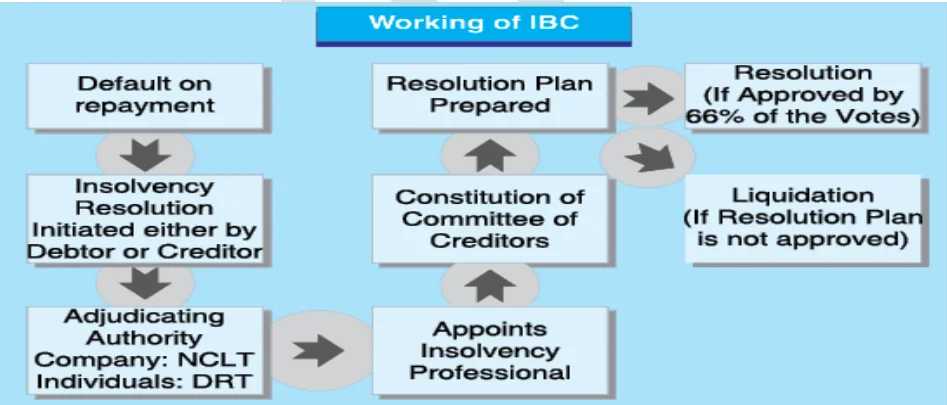Important Facts For Prelims
Insolvency and Bankruptcy Code (IBC) Process
- 27 Nov 2025
- 8 min read
Why in News?
The finance ministry, after reviewing delays in case admissions and resolutions at various National Company Law Tribunal (NCLT) benches, urged banks to adopt a more strategic and coordinated approach to strengthen the Insolvency and Bankruptcy Code (IBC) process for faster timelines and better value recovery.
What is the Insolvency and Bankruptcy Code (IBC) Process?
- Insolvency and Bankruptcy Code (IBC): Enacted in 2016 and based on the recommendations of the T.K. Vishwanathan’s Bankruptcy Law Reforms Committee (2015), the IBC created a unified, time-bound, and creditor-driven framework for resolving corporate distress in India.
- It was introduced when non-performing assets (NPAs) were rising and older mechanisms SARFAESI, Lok Adalats were proving ineffective and slow.
- The IBC ensures that when a business becomes “sick” and defaults on its loans, creditors can recover value quickly, either through resolution (restructuring, sale to new owners) or liquidation.
- Its core objective is to prevent the loss of asset value, maintain a healthy credit cycle, and free up stuck capital to keep the economy vibrant.
- Regulating Authority: The Insolvency and Bankruptcy Board of India (IBBI), a statutory body established under the IBC, 2016, is responsible for formulating rules and regulations for insolvency resolution in India.
- It comprises members from the Ministry of Finance, Ministry of Corporate Affairs, and the Reserve Bank of India.
- Adjudicating Authority: In the IBC, the Adjudicating Authority for corporate persons is the NCLT, while for individuals and firms, it's the Debt Recovery Tribunal (DRT).
- The Committee of Creditors (CoC): It is a decision-making body under IBC, 2016. composed mainly of financial creditors, its primary role is to evaluate, approve, or reject resolution plans for a corporate debtor undergoing the Corporate Insolvency Resolution Process (CIRP).
IBC Process
- Triggering Insolvency: A financial creditor, operational creditor, or the debtor may file for insolvency on default.
- Admission by NCLT: NCLT admits or rejects the application within 14 days. Once admitted, the formal CIRP starts.
- Appointment of IRP: NCLT appoints an Interim Resolution Professional (IRP) to take control of the company, secure assets, and collect financial data.
- Formation of CoC: The IRP forms the Committee of Creditors (CoC) of financial creditors, which decides on revival or sale of the company and may retain or replace the IRP.
- Resolution Plan: Resolution plans are invited, evaluated, and approved by the CoC with 66% votes; failing this, liquidation follows.
- NCLT Approval: The approved plan is submitted to NCLT for final clearance, making it binding on all stakeholders.
- Timeline: CIRP must be completed within 330 days, ensuring faster recovery and preventing value erosion.
Pre-packaged Insolvency Resolution Process (PPIRP)
- The PPIRP is a faster, cost-effective insolvency mechanism introduced for Micro, Small, and Medium Enterprises (MSMEs).
- It was launched through the Insolvency and Bankruptcy Code (Amendment) Ordinance, 2021 to help MSMEs facing financial stress, especially after the COVID-19 pandemic.
- Under the PPIRP for MSMEs, creditors and existing owners can agree out of court to sell the business to an approved buyer (either a third party or a related party).
- The mechanism is currently available for defaults up to Rs 1 crore. It must be completed within 120 days of commencement.
Regulatory Provisions for Asset Recovery in India
- SARFAESI Act, 2002: The Securitisation and Reconstruction of Financial Assets and Enforcement of Security Interest Act, 2002 (SARFAESI Act, 2002) is a core law empowering secured creditors (mainly banks and financial institutions) to recover dues without court intervention.
- The Act enables banks to recover NPAs efficiently by promoting Asset Reconstruction Companies (ARCs) and Securitisation Companies.
- Asset Reconstruction Company (ARC): It is a special type of financial institution that buys the debts of the bank at a mutually agreed value and attempts to recover the debts or associated securities by itself.
- The concept of ARCs was introduced by the Narsimham Committee – II (1998), leading to the establishment of ARCs under the SARFAESI Act, 2002.
Frequently Asked Questions (FAQs)
Q. What is the primary objective of the Insolvency and Bankruptcy Code (IBC), 2016?
The IBC aims to provide a unified, time-bound, creditor-driven framework to resolve corporate distress, preserve asset value, and restore a healthy credit cycle.
Q. Who are the adjudicating and regulatory bodies under the IBC?
The Insolvency and Bankruptcy Board of India (IBBI) regulates the process; the National Company Law Tribunal (NCLT) adjudicates corporate insolvency, while DRTs handle individual/firm cases.
Q. What triggers the Corporate Insolvency Resolution Process (CIRP) and what is the minimum default threshold?
CIRP can be triggered by a financial creditor, operational creditor, or the debtor on default; the content provided states the minimum default threshold is Rs 1 crore.
Q. What is the Pre-Pack Insolvency Resolution Process (PPIRP) for MSMEs and its stipulated timeline?
PPIRP allows out-of-court, creditor-approved sale or restructuring for MSMEs (defaults up to Rs 1 crore as per the content) and must be completed within 120 days to fast-track recovery.
UPSC Civil Services Examination, Previous Year Question (PYQ)
Prelims
Q. Which of the following statements best describes the term ‘Scheme for Sustainable Structuring of Stressed Assets (S4A)’, recently seen in the news? (2017)
(a) It is a procedure for considering ecological costs of developmental schemes formulated by the Government.
(b) It is a scheme of RBI for reworking the financial structure of big corporate entities facing genuine difficulties.
(c) It is a disinvestment plan of the Government regarding Central Public Sector Undertakings.
(d) It is an important provision in ‘The Insolvency and Bankruptcy Code’ recently implemented by the Government.
Ans: (b)







